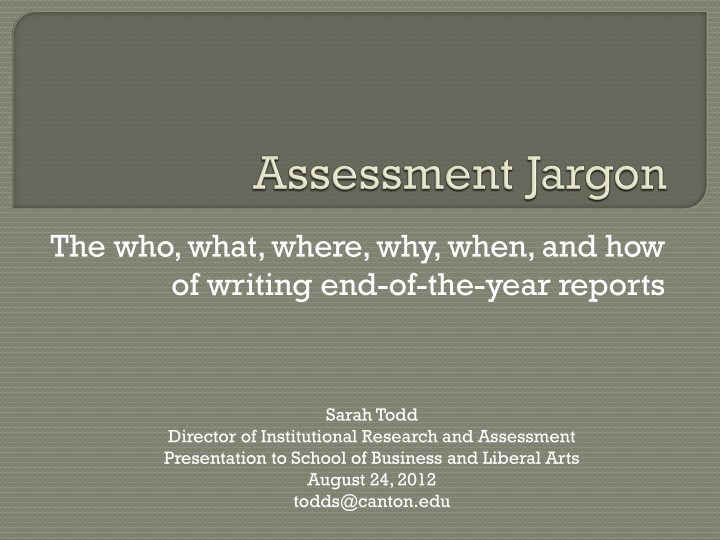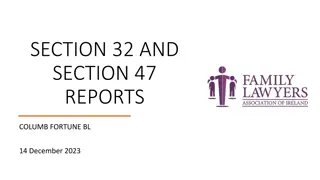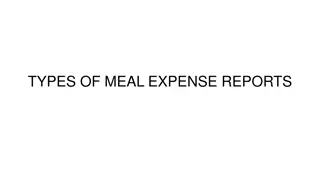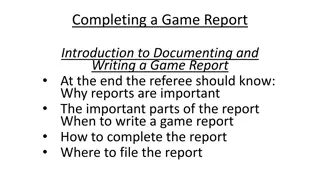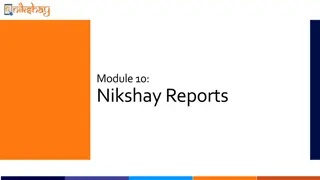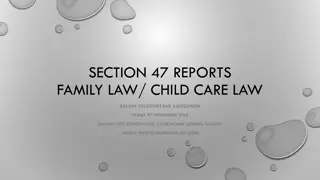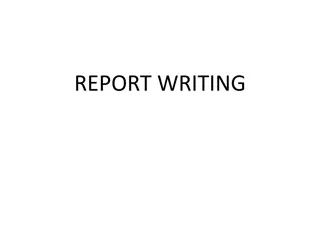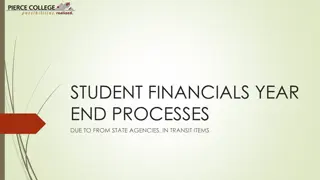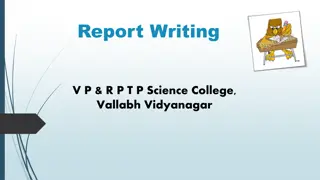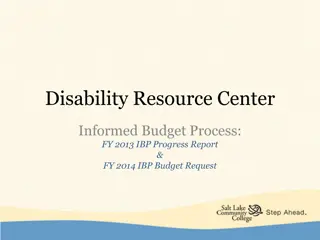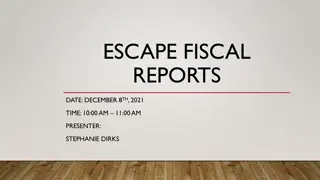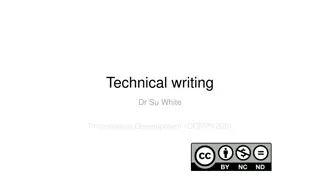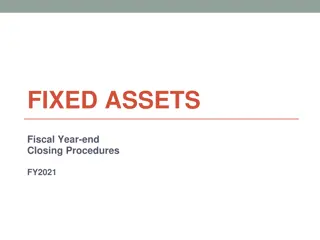Writing End-of-the-Year Reports: Guidelines for Success
Gain insights on crafting effective end-of-the-year reports from Sarah Todd, Director of Institutional Research and Assessment. Explore the essential components of report writing and strategies for presenting data convincingly. This presentation to the School of Business and Liberal Arts offers valuable tips for enhancing your reporting skills. Learn the who, what, where, why, when, and how of writing comprehensive year-end reports that leave a lasting impact.
Uploaded on Feb 15, 2025 | 9 Views
Download Presentation

Please find below an Image/Link to download the presentation.
The content on the website is provided AS IS for your information and personal use only. It may not be sold, licensed, or shared on other websites without obtaining consent from the author.If you encounter any issues during the download, it is possible that the publisher has removed the file from their server.
You are allowed to download the files provided on this website for personal or commercial use, subject to the condition that they are used lawfully. All files are the property of their respective owners.
The content on the website is provided AS IS for your information and personal use only. It may not be sold, licensed, or shared on other websites without obtaining consent from the author.
E N D
Presentation Transcript
The who, what, where, why, when, and how of writing end-of-the-year reports Sarah Todd Director of Institutional Research and Assessment Presentation to School of Business and Liberal Arts August 24, 2012 todds@canton.edu
The systematic collection, review, and use of information undertaken for the purpose of improving outcomes (e.g., student learning and development) Translation: Determining if what we are doing is working, and making changes for improvement, determining if those changes are working, and making further changes for improvement, and making more changes for improvement, and Systematic: organized and planned Review: Appraise critically, evaluate, a formal examination; practice intended to polish performance or refresh memory Use: Take or consume Assessment is not an event, it is a constant process
Assessment Formative: Ongoing to foster improvement Process-oriented: How is it going? Reflective: Based on internally defined goals and criteria Evaluation Timing Summative: Final to gauge quality/performance Product-oriented: What s been accomplished? Prescriptive: Externally imposed standards What is it measuring? Relationship between administrator and recipient Use of findings Diagnostic: Identify areas of strength and weakness Flexible: Adjustable as challenges change Judgmental: Arrive at an overall grade/score Fixed: Designed to reward success and punish failure Standards of measurement
A group of people sharing a specific characteristic: Age Student type Residential/non-residential CSTEP, EOP Program of study First generation Pell eligible
The standard by which things are measured or compared The starting line Census date Previous report date Dictated by a higher power
A description or example of performance that serves as a standard of comparison for evaluation or judging quality Translation: A standard by which something can be measured or judged Types of benchmarks: Peers (aspirational and reality) Where we are now (baseline) Where we want to be Where others say we should be
Goal: A general description of the wider problem your project with address, offering a reason why the task will be performed Objective: More detailed than a goal, includes the who, what, where, why, when, and how Specific: to the problem you are addressing Measureable: changes must be quantifiable, be numeric to address issues of quantity and quality Appropriate/attainable: to the goals and the environment; must be feasible and within your control/influence Realistic: Measures outputs/results not activities Times: Identifies target date for completion of objectives and includes interim steps and a monitoring plan
MEASUREABLE Used to express intended results in precise terms Specific as to what needs to be assessed and help guide the appropriate assessment tool
Observable (documentable!) behaviors or actions that demonstrate that the objective has occurred Your objectives carried over
Direct: Student learners display knowledge and skills as they respond directly to the instrument itself. Objective tests Essays Presentations Classroom assignments Indirect: Student learners reflect on their learning rather than demonstrating it. Surveys (exit, current and graduating students, alumni, employer, etc.) Interviews Focus groups
The goals and objectives you insert in your program scorecard depend entirely on the specific goals and direction of your program The report card can assist you in framing goals and objectives on enrollment, retention rates, graduation rates, admissions, number of graduates and diversity In the next installment, enrollments by student type, average GPA, survey results will be incorporated
Follow a cohort of students through the report card The Fall 2008 cohort size and retention rates can assist in predicting the graduation rates The yield rate and enrollment rate can assist in predicting these as well
Program is currently at a 32% graduation rate. Institutional goal is 40% Set a program goals based on the reality of where you are, the interventions/changes you intend to make, and the direction you need to be heading The yield rate and enrollment rate can assist in predicting these as well
Lets perform an assessment of my presentation, focusing on wardrobe: What is the cohort? What is the baseline? What benchmarks are we going to use? What are the goals? What are the objectives? What are some direct and indirect measures of student learning? What are the outcomes?
